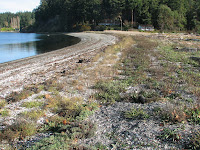skip to main |
skip to sidebar

 Also from November. Battle Point is a neat little cuspate spit and lagoon on the western side of Bainbridge Island. The inlet is on the south shore, while the northern limb shows some signs of continued accretion. Note the newer berm in the upper photo. Erosion of the inlet exposes peat from an earlier incarnation of the lagoon and marsh.
Also from November. Battle Point is a neat little cuspate spit and lagoon on the western side of Bainbridge Island. The inlet is on the south shore, while the northern limb shows some signs of continued accretion. Note the newer berm in the upper photo. Erosion of the inlet exposes peat from an earlier incarnation of the lagoon and marsh.


 After Friday's site visits were postponed, I decided it was time to post a few retrospectives from earlier in the fall. Sadly, I haven't been getting to the beach much the last few months. This is from October 11th, taking the long route back from teaching a Beach Watchers class on Whidbey.
After Friday's site visits were postponed, I decided it was time to post a few retrospectives from earlier in the fall. Sadly, I haven't been getting to the beach much the last few months. This is from October 11th, taking the long route back from teaching a Beach Watchers class on Whidbey.
The rock and concrete on the spit suggest a complicated history - like other spits, large and small (Ediz, Semiahmoo, Shaw's Cove), concern about breaching leads to armoring of the narrowest part of the spit, which may only make things worse. Spits are typically most vulnerable near their bases. Unlike the distal ends, where sediment accumulates to form broad berms, these narrow approaches are just transport corridors and are susceptible to big storms and small changes in sediment supply. Most are probably migrating. Armoring just forces the beach to become narrower and prevents overwash from maintaining the backbone of the spit. Pull the rock off the spit, add some gravel to compensate for decades of neglect, and allow the spit to shift north a little bit.
Ala Spit (sometimes called Ben Ure Spit) is probably not helped by the seawall, fill, and rock groin immediately south, which muck up sediment transport and may simply be encouraging growth of a gravelbars at the expense of the current spit.








